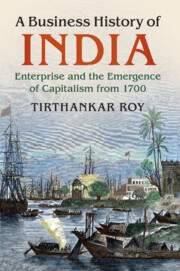Book contents
- A Business History of India
- A Business History of India
- Copyright page
- Dedication
- Contents
- Figures
- Maps
- Tables
- Boxes
- Preface
- 1 Introduction
- 2 The Baseline at 1700
- 3 The Indian Ocean Sphere: 1700–1850
- 4 Capital and Empire (1850–1930)
- 5 Capital and Empire (1850–1930)
- 6 State and Industrialisation: 1930–1950
- 7 State and Industrialisation: 1950–1980
- 8 Revival: 1980–2000
- 9 Capital and Globalisation: 2000–2015
- 10 Conclusion
- References
- Index
4 - Capital and Empire (1850–1930): Trade and Finance
Published online by Cambridge University Press: 20 March 2018
- A Business History of India
- A Business History of India
- Copyright page
- Dedication
- Contents
- Figures
- Maps
- Tables
- Boxes
- Preface
- 1 Introduction
- 2 The Baseline at 1700
- 3 The Indian Ocean Sphere: 1700–1850
- 4 Capital and Empire (1850–1930)
- 5 Capital and Empire (1850–1930)
- 6 State and Industrialisation: 1930–1950
- 7 State and Industrialisation: 1950–1980
- 8 Revival: 1980–2000
- 9 Capital and Globalisation: 2000–2015
- 10 Conclusion
- References
- Index
Summary
After the British Crown took over administration of the Company's territories in India (1858) the integration of agricultural production with overseas trade was built on a stronger foundation than before, based on modern transport and communication infrastructure, administrative and military integration of the interior with the coast, and a legal framework. The imperial state intervened in the economy mainly by legislating on property and contract. Whereas the aim of property law was to ensure revenue, the aim of the latter was to integrate the Indian economy with the Britain-centred world economy. Standardisation of law was a vital matter for the British Empire, which functioned as a giant customs union with few formal barriers to the movement of goods, capital, and labour between its parts. Standardisation of commercial law was a condition for this setup to work.
Trade volume grew manifold. Businesses specialised into segments. Three nineteenth-century technologies – railways, steamships, and the telegraph – greatly reduced trade costs. Laws helped joint-stock and limited liability to be used more widely. Companies formed in manufacturing, in trading, and in banking. What did these companies do? Most firms, corporate or family run, Indian or European, either traded directly or had an interest tied to trade.
Historians observe that trade was free in this time within the imperial sphere. In fact, free factor movement was a more significant thing than free trade. From about 1860, British capital inflow into India increased, along with migration. It was easy for a company based in India to hire managers and technicians from abroad and sometimes to borrow abroad. The balance of payments bears witness to the fact that businesses were doing this on a large scale. Trade was ordinarily in surplus, and the surplus balanced a net payment for services purchased abroad, both by the government and private enterprise, and transfers made by the British working in India.
As the financial system expanded to be able to fund trade, agricultural business boomed. While corporate banks and big indigenous banking firms financed mainly merchants, some of the money they invested every season filtered through the hands of medium- and small-scale moneylending firms down to the peasant cultivators. A part of the trading and banking profits earned in agricultural trade were re-invested in industry. The main industries, cotton and jute textiles, processed agricultural raw materials. An experience in trading these goods made the move to industry more likely.
- Type
- Chapter
- Information
- A Business History of IndiaEnterprise and the Emergence of Capitalism from 1700, pp. 69 - 100Publisher: Cambridge University PressPrint publication year: 2018



